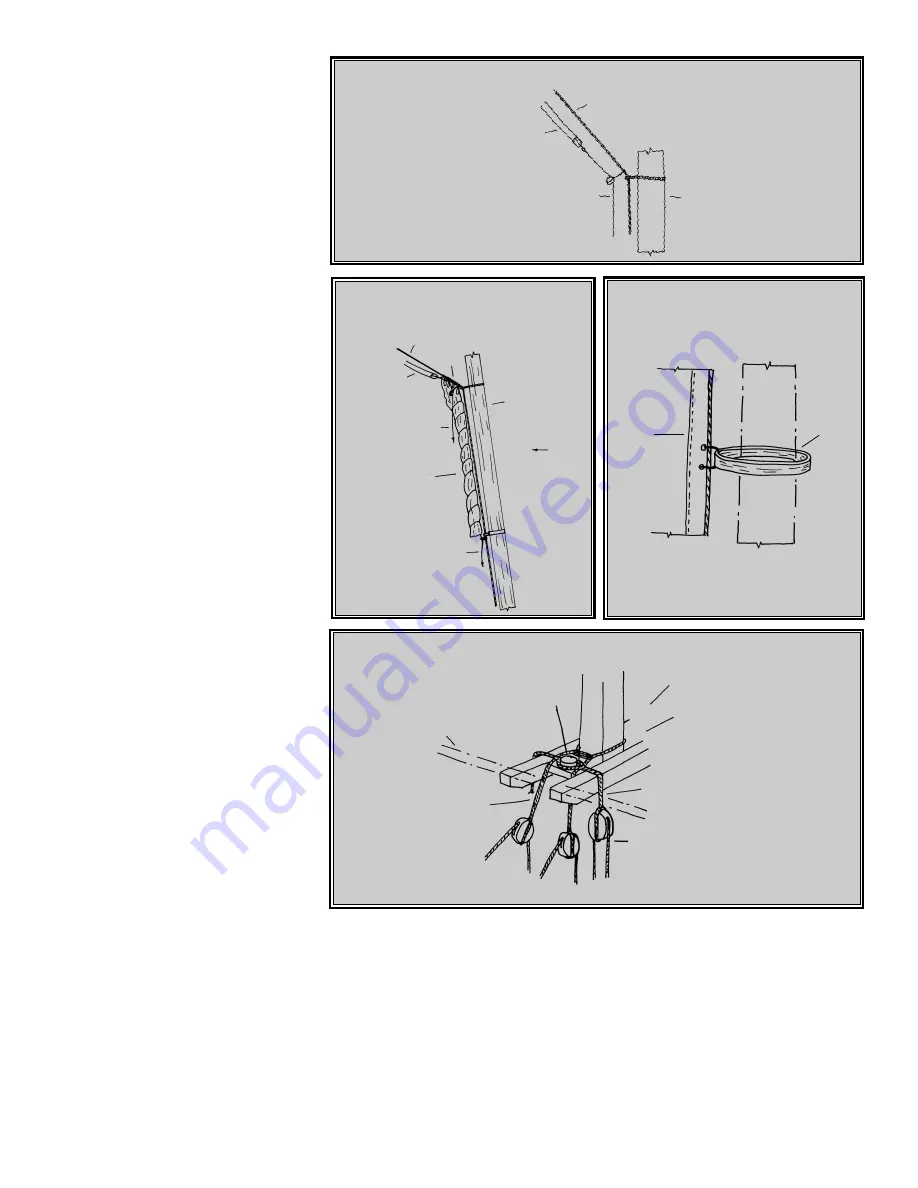
35
near the boom head. Attach these short
lines and the downhaul blocks to a
grommet on the guys.
No Sails
: Attach halliards to the down-
hauls and lead them to the end of the
bowsprit (Figure 9-1). Halliard runs are
identical to a rig with sails except for
the head block's location. Remove
sheets with the sails. If left on deck, they
tend to clutter a model. Also, don't put
hanks on the stays.
Furled Sails
: Figure 9-2 illustrates a
furled outer jib and flying jib. Notice
their diminutive bulk and how hanks
are gathered together. Fat furled sails
are not realistic.
2. Main Staysails
Rig the staysails between the fore and
mainmasts with hanks, downhauls, hal-
liards, and sheets. The main topgallant
staysail has a tack with thimble on the
topgallant stay. The topmast staysail tack
reeves through a fairlead on the topmast
stay, then belays on deck.
Note:
Niagara
often sets the fore staysail
on the main stay. The foremast generally
carries a storm sail. If rigging the fore
staysail, adjust the belaying arrange-
ment to open up pins for it.
No Sails
: Omit sheets and tacks. Hook
the downhauls and halliards together
(Figure 9-3).
Furled Sails
: Figure 9-4 illustrates the
furled main topmast staysail. Again, it is
a compact, round bundle.
3. Spanker
Do as much work as possible with the
boom and gaff in hand. When installing
them, the most difficult task will be
sewing the spanker mast hoops to the
sail (Figure 9-5).
Reeve lines, but leave them loose. Set
the boom sheet, then tighten the peak
and throat halliards. Fit the brails, fol-
lowed by the topping lifts and vangs.
Add the flag halliard after making a
standard. Topping lifts and throat hal-
liard have collars at the masthead
(Figure 9-6).
Lace the spanker to the gaff, but leave it
loose footed at the boom (Figure 9-7). Hook
the port tack tackle to a deck eyebolt, then
belay it to the cleat on the fife rail bitt.
No Sail
: The most accurate approach is
lowering the gaff on top of the boom.
However, some modelers prefer to leave
it up, since it fills the space aft of the
mainmast. Use the vangs to position the
gaff and prevent it from swinging.
Remove brails with the sails, but rig all
blocks attached to the gaff. Pile mast
hoops at the boom. Topping lifts hold it
up. Other lines remain in place.
Furled Sail
: Figure 9-8 illustrates a furled
spanker. Pull the clew up to the middle
brail block on the mast and lead the
clew outhaul to the boom end.
Boom Guys and Tiller Guys
: Boom and
tiller guys are used when the sails are
furled or off. Although they steady the
boom and tiller, the boom guy could
assist the boom sheets in heavy weather.
Bend, furl, or omit the fore and aft sails.
Fig 9-3 Topmast Staysail Removed
Fig 9-4 Furling the Main
Topmast Staysail
Fig 9-5 Sewing Mast Hoops
Main topmast stay
Foremast
Downhaul
Halliard
Topmast stay
Hanks
Foremast
Mast hoop
Punch holes
& sew with
thread
Other
staysail
similar
Tack
Downhaul
Sail bundle
laced, but in
photo does
not appear to
be laced to
the stay
Fig 9-6 Spanker Halliard / Lift Collars
Top
Top of
Spanker Mast
Topping lift
collar
P/S
Spanker throat
halliard collar
Shrouds not shown
Cut holes in platform where
required for collars






































